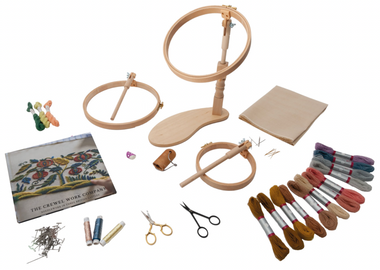At the 2026 Lady Anne’s Online Needlework Festival , we are thrilled to feature the Glamis Stomacher , a glamorous new design by Deborah Wilding inspired by a 16th-century portrait of Lady Arbella Stuart, an English noblewoman and potential heir to the throne, whom some hoped would succeed Queen Elizabeth I.

Unlike many of our historic embroidery designs, this project is based not on a surviving textile but on the rich details captured in a painting, allowing stitchers to bring to life an embroidery that no longer exists but that was once cherished enough by its owner to be featured in her likeness.
A Design Born from Portraiture
The portrait, which hangs in Glamis Castle’s Drawing Room, shows Lady Arbella wearing a beautifully embroidered stomacher.

Though the original garment has long since disappeared, and restoration on the painting has worn away the detail on the stomacher, Deborah has carefully interpreted its motifs, colours, and textures to recreate a piece of history in thread.
“Translating a painted stomacher into embroidery was a unique experience - each thread brought the portrait’s beauty and history to life.”
— Deborah Wilding
The result is a design that invites participants to experience the artistry and taste of one of the Tudor era’s most fascinating, but largely forgotten, female figures.

About Lady Arbella Stuart
Born in 1575 at Hardwick Hall, Arbella Stuart was the only child of Charles Stuart, 1st Earl of Lennox, and Elizabeth Cavendish. As a great-great-granddaughter of King Henry VII of England, Arbella was closely linked to the English throne, making her a significant figure in royal succession. Her maternal grandparents were Sir William Cavendish and his wife Elizabeth, better known as "Bess of Hardwick".

Though raised in privilege, Arbella’s life was tightly controlled by Queen Elizabeth I, who watched her closely due to her potential as a claimant to the crown.
Her life was marked by intrigue, including a secret marriage to William Seymour in 1610, imprisonment in the Tower of London, and ultimately her death there in 1615. Despite these dramatic events, Arbella’s surviving portraits reveal a deep appreciation for lavish embroidery, highlighting her refined taste and meticulous attention to detail.
A Two-Day Experience with Deborah Wilding
Over two days, Deborah will guide the class step-by-step, teaching techniques in silk and metal threads that recreate the luxurious motifs on Arbella’s stomacher. Stitched on a regal silk, students will learn multiple techniques in silk thread including Closed fly stitch, Laid work technique, Satin stitch, and French knots. Then with four types of metal threads Deborah will teach Couching, Plate application, Burden stitch, Couching pearl purl, Chipping, Outlining with stretched pearl purl, and weaving to create a braid stitch effect on the stem.
The kit for the class will contain full instructions so you are not left on your own after the class and all students will have lifetime access to recordings.

This class is ideal for stitchers eager to explore historical embroidery through a portrait-inspired design, offering both challenge and inspiration while celebrating one of history’s most intriguing women.
Sign up for Deborah's class today.
Find out More 





